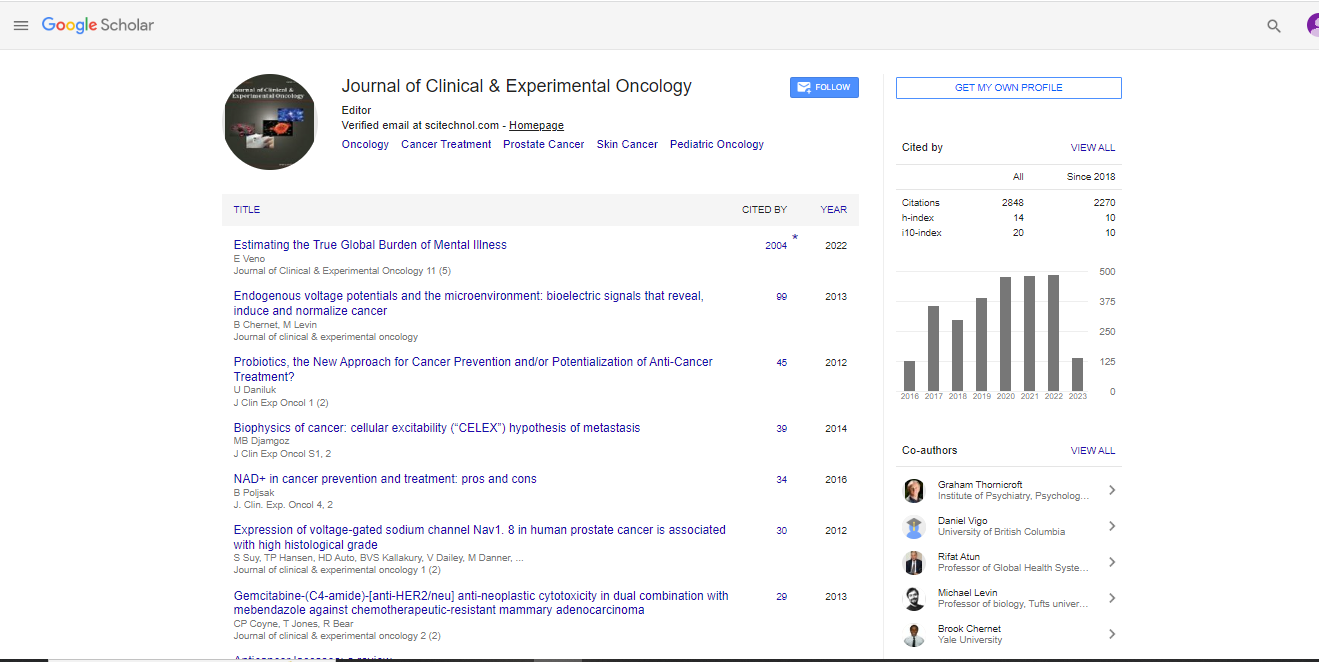Opinion Article, J Clin Exp Oncol Vol: 13 Issue: 4
Assessing the Types of Carcinogens and Prevention Strategies for a Healthier Life
Tashima Hasino*
1Department of Oncology, National Cancer Center Research Institute, Tokyo Japan
*Corresponding Author: Tashima Hasino,
Department of Oncology, National
Cancer Center Research Institute, Tokyo Japan
E-mail: tashimo_hasinonccr@11.jp
Received date: 21 July, 2024, Manuscript No. JCEOG-24-148876;
Editor assigned date: 23 July, 2024, PreQC No. JCEOG-24-148876 (PQ);
Reviewed date: 06 August, 2024, QC No. JCEOG-24-148876;
Revised date: 13 August, 2024, Manuscript No. JCEOG-24-148876 (R);
Published date: 20 August, 2024, DOI: 10.4172/2324-9110.1000420
Citation: Hasino T (2024) Assessing the Types of Carcinogens and Prevention Strategies for a Healthier Life. J Clin Exp Oncol 13:2.
Description
Carcinogens are substances or agents that can lead to the development of cancer by altering cellular processes and causing mutations in DNA. The risk of exposure to carcinogens is a significant public health concern, as these substances are present in the environment, workplaces and even the products one can use daily. Understanding the types of carcinogens and adopting effective prevention strategies can greatly reduce the risk of cancer and lead to a healthier life. Carcinogens can be broadly categorized into three types: Chemical, physical and biological. Each category contains substances that have been linked to cancer, though the mechanisms by which they cause damage to cells vary.
Chemical carcinogens are substances that can induce cancer after exposure, often through inhalation, ingestion or skin contact. These carcinogens may be naturally occurring or synthetic and can be found in industrial settings, consumer products and the environment. One of the most well-known chemical carcinogens is tobacco smoke. It contains thousands of chemicals, over 70% of which are classified as carcinogenic, including benzene, formaldehyde and Poly-Aromatic Hydrocarbons (PAHs). Smoking is the leading cause of lung cancer, accounting for approximately 85% of all lung cancer cases worldwide.
Asbestos, a naturally occurring mineral, was once widely used in construction, insulation and various industries. Prolonged inhalation of asbestos fibers can cause lung cancer, mesothelioma and asbestosis. Although asbestos use has been banned in many countries exposure can still occur in older buildings and certain work environments. Benzene, commonly used in industrial processes, benzene is a known carcinogen linked to leukemia and other blood disorders. It is found in cigarette smoke, gasoline and products like solvents and detergents. Many agricultural chemicals, including pesticides and herbicides, have been linked to cancer particularly among farmers and agricultural workers who have prolonged exposure.
For example, glyphosate, a common herbicide has been classified as a probable carcinogen by the International Agency for Research on Cancer (IARC). Physical carcinogens refer to physical agents or forms of radiation that can cause cancer by damaging cellular DNA.
Prolonged or high levels of exposure to these agents can increase the risk of cancer development. Ultraviolet (UV) radiation from the sun is a major cause of skin cancer, including melanoma, basal cell carcinoma and squamous cell carcinoma. Overexposure to UV radiation can lead to mutations in the skin’s DNA, promoting uncontrolled cell growth. Ionizing radiation, such as X-rays and gamma rays, can penetrate the body’s tissues and damage DNA. This type of radiation is used in medical imaging and cancer treatments but can also be harmful when exposure levels are too high or prolonged.
Radon, a naturally occurring radioactive gas found in certain soils and rocks is another source of ionizing radiation linked to lung cancer. Workers in industries like mining, construction and radiology may be exposed to physical carcinogens such as radiation or particulate matter. This occupational exposure, if not managed properly, can significantly increase cancer risks. Biological carcinogens include certain viruses, bacteria and parasites that can cause cancer by inducing chronic infections or directly affecting cellular processes. Human Papillomavirus (HPV) is a common sexually transmitted virus responsible for nearly all cases of cervical cancer. Some strains of HPV can also cause cancers of the throat, anus and penis. Vaccination against HPV can significantly reduce the risk of these cancers.
Chronic infections with Hepatitis B and C Viruses (HBV and HCV) are major risk factors for liver cancer. These viruses cause long-term liver damage, increasing the likelihood of cancerous mutations. Helicobacter pylori bacterium, which causes chronic stomach infections, has been linked to gastric cancer. These infections lead to chronic inflammation and can damage the stomach lining, increasing the risk of cancer over time. Certain parasitic infections, such as those caused by schistosoma, are associated with bladder cancer. These parasites are prevalent in certain tropical and subtropical regions and are transmitted through contaminated water. While some carcinogen exposures are unavoidable, many can be reduced or eliminated through lifestyle changes and preventive measures.
The most effective strategy to prevent cancer is avoiding tobacco use. Smoking cessation dramatically reduces the risk of lung cancer and other cancers linked to tobacco, such as mouth, throat and bladder cancer. Avoiding exposure to secondhand smoke is also essential for non-smokers. Reducing UV exposure is essential for preventing skin cancer. Strategies include wearing protective clothing, applying broadspectrum sunscreen with a high Sun Protection Factor (SPF), seeking shade and avoiding tanning beds. It is also important to regularly check the skin for unusual moles or spots and to have annual dermatological screenings.
Conclusion
Understanding the types of carcinogens chemical, physical and biological and taking steps to reduce exposure is essential for preventing cancer and leading a healthier life. While some risks may be unavoidable, many can be reduced through lifestyle modifications, workplace safety, vaccinations and regular health screenings. By being proactive in managing exposure to carcinogens, individuals can greatly reduce their risk of developing cancer and improve their overall well-being.
 Spanish
Spanish  Chinese
Chinese  Russian
Russian  German
German  French
French  Japanese
Japanese  Portuguese
Portuguese  Hindi
Hindi 



